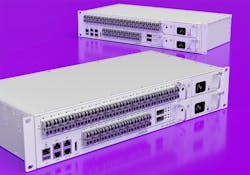ADVA achieves MEF 3.0 certification for 100G services
ADVA on Dec. 20 announced that its FSP 150-XG480 has become the first 100Gbit/s solution on the market to achieve MEF 3.0 Carrier Ethernet certification. Per the manufacturer, the compact metro edge device is now the industry’s only 100Gbit/s packet aggregation and demarcation technology proven to offer the highest available levels of performance, assurance and agility.
With the ADVA FSP 150-XG480, enterprises and communication service providers (CSPs) can address the boom in cloud computing and mobile services by smoothly transitioning to 10 and 25Gbit/s service aggregation. Further, ADVA’s MEF 3.0-compliant technology enables them to meet the need for high-capacity wholesale, mobile and business services with a solution that supports automated networking and 5G-ready architectures.
“CSPs now have the power to tackle the demand for 100Gbit/s aggregation at the metro edge with a solution guaranteed to deliver the highest industry standards for performance and assurance. With our unique technology, there’s now a simple and extremely cost-efficient route to MEF 3.0-certified 100Gbit/s service aggregation,” said James Buchanan, GM, Edge Cloud, ADVA. “Higher speeds in the access network are becoming essential. In fact, with the emergence of more and more connected devices as well as the unprecedented surge in video streaming platforms, 10Gbit/s is becoming the new 1Gbit/s. What our FSP 150-XG480 offers is a future-proof way to deliver MEF CE services up to 100Gbit/s and enable the efficient and reliable aggregation of multiple 10Gbit/s streams.”
The compact, powerful ADVA FSP 150-XG480 aggregator with high-density 1, 10 and 25Gbit/s port count is billed as "the ultimate tool for fighting bandwidth bottlenecks and evolving metro networks to 100Gbit/s. Its MEF 3.0-compliant interfaces and operation and management capabilities enable seamless integration into existing networks and established processes," adds the company. The ADVA FSP 150-XG480 offers a range of advantages for connectivity and synchronization in mobile backhaul networks. These include leveraging ADVA’s Oscilloquartz Syncjack technology to constantly control the accuracy of network timing. As further noted by the manufacturer, "It’s also the only device available with 100Gbit/s line-rate service activation and testing, so there’s no need for CSPs to compromise on high-value SLA-based business services."
“Achieving MEF 3.0-compliant status with our FSP 150-XG480 highlights the leading role ADVA continues to play in the Carrier Ethernet space. This certification is also great news for enterprises across the world as well as mobile network operators looking to meet soaring data demand. Now they can map 10 and 25GbE into 100Gbit/s aggregated bandwidth with a solution that easily expands to meet the coming requirements of 5G networks,” commented Eli Angel, VP, product line management, Ethernet access, ADVA. “Our FSP 150-XG480 is the key to future scalability. It also features an incredibly small form factor and environmentally hardened design, delivering a significant cost advantage over competing technology.”
For more information, visit www.adva.com.
